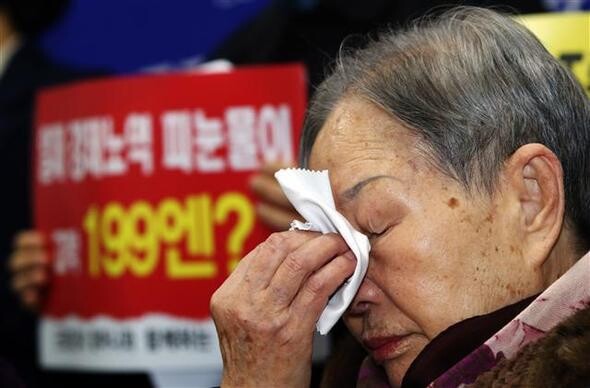hankyoreh
Links to other country sites 다른 나라 사이트 링크
One elderly women’s emotional wounds still unhealed from forced labor

Kim Jae-rim, 87, was a member of the Korean Women's Volunteer Labor Corps. In late May 1944, she went to Japan on the understanding that she would be sent to a girls’ school but was instead forced to work at an aircraft production facility in Nagoya that was operated by Mitsubishi Heavy Industries until the end of Oct. 1945, without receiving a single penny for her work. Kim barely managed to escape from the rubble of a building that collapsed in a major earthquake in Dec. 1944, but searchers never found the body of her cousin, who had been trying to escape with her. After returning to Korea without receiving any wages, Kim got married at the age of 20 and had a son and daughter before losing her husband. Since then, her life has had many twists and turns.
Women who worked in the Korean Women's Volunteer Labor Corps, called “Geunro Jeongsindae” in Korean, have suffered because of the term’s similarity to “Jeongsindae,” meaning “comfort women.” Between 1944 and 1945, the Japanese empire drafted young women in their early and mid-teens into the labor corps for work at munitions factories. These women worked for companies such as the Tokyo Ramie Spinning Company, Mitsubishi Heavy Industries and Fujikoshi Steel. They were not the same as the comfort women, who were drafted by the Japanese empire to work at its comfort stations and had to serve as sex slaves for the Japanese army. But because the word “Jeongsindae” also appears in “Geunro Jeongsindae,” these women had to choke back their tears without being able to explain themselves because of the prejudice of those around them.

A total of 288 young women between the ages of 13 and 15 were drafted into the labor corps (138 from Jeolla Province and 150 from Chungcheong Province). At the time, the Japanese government mobilized around 200,000 young women, from Japan and Korea, for labor corps. Between 50,000 and 70,000 are estimated to have come from Korea. In 2009, the Japanese government mocked these women by paying seven former members of the labor corps, including Yang Geum-deok, 99 yen (US$0.89) to compensate them for their disenrollment from the welfare and pension system. Yang and seven former members of the labor corps filed a damages lawsuit against the Japanese government and Mitsubishi Heavy Industries in Mar. 1999, but in Nov. 2008, the Supreme Court of Japan ruled against them, finding that all rights to make claims had been annulled by the treaty signed by South Korea and Japan in 1965. Since 2012, three damages lawsuits that former members of the labor corps have filed against Mitsubishi Heavy Industries have been in progress at the Gwangju District Court.
At 3 pm on Apr. 7, Kim, who is currently living at a nursing home in Gwangju, went to Room No. 403 of the Gwangju District Court. She was there for the second round of questioning in a damages lawsuit filed against Mitsubishi Heavy Industries. In the first damages lawsuit filed by Yang and four other people, the district and appeals court both sided with the plaintiffs, and the case is currently pending in the Supreme Court. The testimony that Kim submitted to the court on Mar. 30 was a tearstained letter that lays bare her emotional wounds.
By Jung Dae-ha, Gwangju correspondent
Please direct questions or comments to [english@hani.co.kr]

Editorial・opinion
![[Guest essay] Preventing Korean Peninsula from becoming front line of new cold war [Guest essay] Preventing Korean Peninsula from becoming front line of new cold war](https://flexible.img.hani.co.kr/flexible/normal/500/300/imgdb/original/2024/0507/7217150679227807.jpg) [Guest essay] Preventing Korean Peninsula from becoming front line of new cold war
[Guest essay] Preventing Korean Peninsula from becoming front line of new cold war![[Column] The state is back — but is it in business? [Column] The state is back — but is it in business?](https://flexible.img.hani.co.kr/flexible/normal/500/300/imgdb/original/2024/0506/8217149564092725.jpg) [Column] The state is back — but is it in business?
[Column] The state is back — but is it in business?- [Column] Life on our Trisolaris
- [Editorial] Penalties for airing allegations against Korea’s first lady endanger free press
- [Editorial] Yoon must halt procurement of SM-3 interceptor missiles
- [Guest essay] Maybe Korea’s rapid population decline is an opportunity, not a crisis
- [Column] Can Yoon steer diplomacy with Russia, China back on track?
- [Column] Season 2 of special prosecutor probe may be coming to Korea soon
- [Column] Park Geun-hye déjà vu in Yoon Suk-yeol
- [Editorial] New weight of N. Korea’s nuclear threats makes dialogue all the more urgent
Most viewed articles
- 1[Column] Why Korea’s hard right is fated to lose
- 2Amid US-China clash, Korea must remember its failures in the 19th century, advises scholar
- 3[Column] The state is back — but is it in business?
- 4Yoon’s broken-compass diplomacy is steering Korea into serving US, Japanese interests
- 5S. Korean first lady likely to face questioning by prosecutors over Dior handbag scandal
- 6[Column] Life on our Trisolaris
- 7Lee Jung-jae of “Squid Game” named on A100 list of most influential Asian Pacific leaders
- 8[Guest essay] Preventing Korean Peninsula from becoming front line of new cold war
- 960% of young Koreans see no need to have kids after marriage
- 10After 2 years in office, Yoon’s promises of fairness, common sense ring hollow